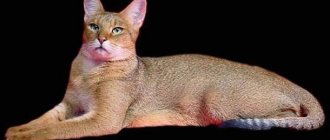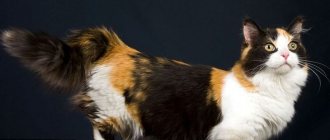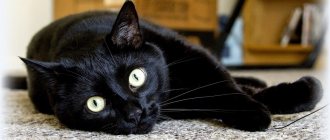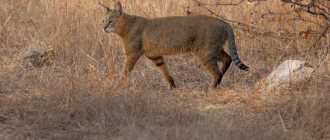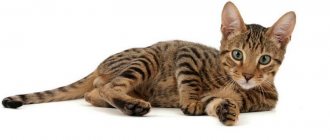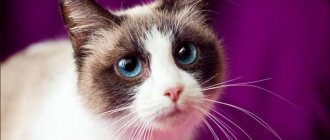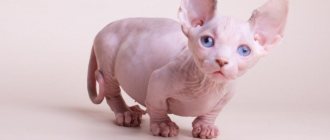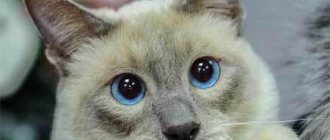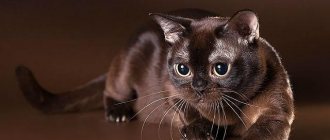| Origin | Türkiye |
| Wool | semi-long |
| Dimensions | weight 4-9 kg, height 35-40 cm at the withers |
| Lifespan | 15-17 years old |
The Van cat or Turkish van is a rare case - the variety has an aboriginal origin and an ancient history. For thousands of years, these animals interbred naturally, becoming the natural basis for most modern breeds. The name of the cats is associated with their homeland - a section of the Armenian Highlands near Lake Van. The species is characterized by excellent health, a stable phenotype and a gentle cat disposition.
Origin story
The appearance of Van cats is associated with an ancient legend of a religious nature. As Noah's Ark made its fateful voyage, the devil sent a mouse to gnaw a hole in the wood and sink the ship. The white cat caught the rodent and saved humanity, for which God blessed the animal, marking it with a bright golden color.
The native Turkish Van is a breed of cat that has not left its habitat for a long time. Several specimens came to Europe along with the crusaders and served as decoration for aristocratic houses. In the 17th century the animals were brought by travelers from Western Armenia, although at that time the Vans were not distinguished from the Turkish Angora. Cats that look similar to Van cats are depicted in the paintings of M. Gerard and A. J. Bayle, written in the 18th century. The description of the breed is also mentioned in letters of the French archaeologist and artist de Laval in 1856.
Modern Turkish baths became of interest to breeders in the 50s. 20th century The English journalist L. Lushington brought a pair of Van cats with the aim of popularizing the breed among European felinologists. The interesting white and red color of the kittens, the kids' unexpected love for water and the water-repellent properties of the fur made this species stand out from others. Therefore, already in 1969, the “Turkish cat” was registered in England, and in 1979 – in the USA.
The international community only adopted a breed standard in 1994. However, there are differences in the description of cats in Europe, Turkey and the USA, especially in relation to color. This is the reason for the lack of prevalence of the Turkish Van and affects the cost of kittens.
Nutrition
A nutritious diet rich in a complex of vitamins, proteins, fats and carbohydrates will help keep your cat in good shape. The activity of this breed must be supplemented with high-calorie, balanced food from trusted producers. To replenish vital resources, cats are suitable for dry food and canned food. However, it is worth considering that low-quality and cheap food, on which owners often want to save money, leads to irreparable consequences. Such foods are most dangerous for the health of the gastrointestinal tract, liver and kidneys - the most vulnerable organs of any member of the cat family. It is worth choosing food from quality manufacturers, such as Hills, Purina, Eukanuba, Royal canin.
Recommended reading:
Review of the Havana Brown breed: character, how to care for, what to feed
Van Kedisi suffer from a predisposition to allergic reactions. It is necessary to exclude salty and sweet dishes from the menu, not to mention spicy ones. For such cases, there are specialized hypoallergenic foods that can be found in any specialty store. It is worth noting that the main allergen for all representatives of the cat family is chicken, so adherents of natural food should accustom their pets to seafood, fish and fermented milk dishes.
Young cats should receive from food those elements that are necessary for their growth and development; before the age of two years, cats' nutrition should be saturated with vitamins D, proteins and carbohydrates. Calcium, which is contained in protein foods, will ensure the growth of skeletal bones and give the coat a healthy appearance. Another important criterion in feeding a domestic cat is the number of meals.
For an adult cat, 2 doses a day are enough, otherwise she will begin to gain weight, which will have a detrimental effect on her joints.
Kittens
Description and standard
Representatives of the Turkish breed are quite large, the body length of an adult animal reaches 1.3 m (with tail) with a height of up to 40 cm. The weight of males is 8-9 kg, and females are much smaller and weigh 5-6 kg. From the photo it is noticeable that the van’s skeleton is well developed, equipped with powerful muscles, and the pet itself looks athletic.
The International Standard describes the Van cat as follows:
- The skull resembles a truncated triangle with a large chin and a profile close to straight.
- Powerful chest.
- The neck of the Turkish Van is wide and long.
- Tail length and hairiness are medium.
- Straight, high-set, large ears have rounded tips.
- Large oval eyes are located slantingly.
- Legs of medium length with rounded paws.
- The pads and fingers are pink, as is the nose.
Color features of Van cats
The Turkish Van can be unmistakably recognized by the colored markings on its white coat. Moreover, these marks can have any classic color or pattern , in particular, tabby.
The markings that are located on the tips of the tail may have white dots. The colored part of the fur can cover the cat's tail and head, but not more than 20 percent of it. If there is a tabby pattern, then the tail is ringed with stripes, where the color on top will be brighter. In some cases, the animal also has color prints on the left shoulder . In Turkish legend it is said about him that this is God’s mark, which blessed the cat to fight the mice that made holes in Noah’s Ark with the help of evil spirits.
The marks most often have the following shades:
- cream;
- cake;
- ginger;
- blue;
- black.
The peculiarities of the breed are such that completely white fur is allowed on the Turkish Van; this is called “van kedisi” when there is not a single mark or pattern of a different shade on the animal’s body.
The paw pads and nose of all representatives of the breed are usually pink.
Features of character and behavior
The Turkish Van is a monogamous breed; the breed becomes attached to only one person, whom it recognizes as its owner. At the same time, the animals retain their autonomy and independence. The pet will choose the time when it comes to receive its portion of affection. The Turkish Van cat will willingly lie on the owner’s lap, purr, and even more willingly sit on the shoulders. However, the cat recognizes only himself as the main person in the house.
The description of the breed focuses on the special relationship of cats to water. The instincts of the Turkish Van are different from other species - wet fur does not frighten the animals. The pet willingly swims, plays in the bathtub while bathing, and hunts for streams from the faucet.
A penchant for games is also characteristic of the Turkish cat. The energetic van is able to tirelessly frolic with artificial mice, baits and rustling wrappers.
This breed is completely unsuitable for lovers of a quiet life. The Turkish Van will not lie peacefully in a chair; he will rather run around the rooms, knocking down everything in his path. Agile and resilient animals must shed accumulated energy daily. Otherwise, curtains, furniture and fragile interior items will suffer. That's why this type of cat looks more like a dog. If you teach your Van to wear a harness from childhood, the kitten will happily go for walks and spend more time in nature.
Every cat of this breed loves to talk with the owner, actively using not only a wide vocal range, but also facial expressions. The Turkish Van will definitely report that he is hungry, sad, bored or sees a bird in the window. The friendly nature of the cat allows you to get along with dogs if they allow themselves to be led.
The Van breed always strives to take a dominant position in the house.
Animal character
The owners of these cats note the following qualities in them:
- mind;
- loyalty;
- attachment;
- manifestations of tenderness;
- activity.
Cats have very strong legs, thanks to which they are able to climb even the tallest cabinets. They like to choose comfortable spots at the top of rooms and watch what's going on from there.
Van kittens are distinguished by their playfulness, although such spontaneity and activity are characteristic of older representatives of this breed. They love to grab objects and toys on the fly, roll around on the floor and run around a lot. Turkish Vans also love water and can swim for a long time. They are also excellent hunters by nature.
Turkish Van
These animals are very curious and love communication, including with other pets. their superiority in such cases , and will in every possible way focus the attention of the owners on their person. He will be constantly in front of your eyes.
Cats not only love to be active and play, they also have a penchant for more intellectual entertainment. For example, they are ready to learn more serious things . For example, they can bring slippers and other items to the owner when needed. Van cats are distinguished by loyalty, perseverance and intelligence.
In terms of communication with their owners, they are quite demanding. The Vanir want to be communicated with long and loudly, as with an equal. Also, if they are strongly attached to one owner, then it will be extremely difficult for them to get used to a new one.
Health
The Van breed has good health, thanks to its natural origin and long-term free crossing. Turkish cats are not prone to any diseases that are unique to them. Like all cats, Vans are often born with hypertrophic cardiomyopathy, which is characterized by symptoms such as lethargy, shortness of breath, and apathy. The disease has no cure, only supportive therapy.
Due to genetic characteristics, it is not recommended to cross two animals of pure snow-white color. This significantly increases the risk of producing kittens with hereditary deafness.
The dominant allele of the white coat genes affects the formation of the inner ear and causes a mutation in the early stages of embryonic development. If at least one van in a pair has a colored color, then the chance of having deaf kittens is significantly reduced.
The Turkish cat is characterized by a high level of immunity, rarely catches colds and is able to cope with simple viruses on its own. And to prevent dangerous diseases, it is enough to follow the vaccination regime and carry out deworming in a timely manner.
Poor nutrition or improper care can cause:
- allergies;
- hormonal imbalance;
- gingivitis;
- arterial thromboembolism;
- urolithiasis.
If you give your pet proper attention and care, the van will live at least 15 years.
Health of Turkish Van cats
Turkish Vans are distinguished by relatively good health and good immunity. Unless they may develop hypertrophic cardiomyopathy, that is, thickening of the wall of one of the ventricles of the heart. But with good therapy, a cat can lead a completely happy life.
Well, like all white-haired cats, when crossing two white individuals, there is a high probability of the birth of a kitten with deafness. Otherwise, this is a healthy breed, not prone to any specific diseases, living up to 15 years, which is a respectable age for them.
How to choose a kitten
Rare Van cats, photos of which can be seen on the Internet, are not available for free purchase. Under no circumstances should you trust private advertisements or offers to buy a van without documents. First, you will have to reserve the baby from an official breeder who is registered with the international felinological club.
Do not forget that a kitten, even in its native Turkish nursery, must be healthy and also correspond to the description of the breed.
When choosing a pet you should consider:
- breeder's reputation;
- availability of a veterinary passport;
- purity of pedigree;
- baby's appearance.
To be able to assess the development and condition of Van, the kitten should not be younger than 3 months. The animal must eat independently, have a well-fed, strong body, and behave actively and inquisitively.
Price and where to buy a Turkish Van kitten
It is very difficult to find a kitten of this breed in Russia, but if you are lucky, its price can range from 7 to 30 thousand rubles. If the baby is brought from abroad, then the cost may even jump to 100 thousand rubles.
Naturally, a purebred kitten must have a birth certificate or pedigree and a veterinary passport. The baby must be active, with clean eyes and ears and at least 3 months old.
It is also worth remembering that in order to avoid deception, you should choose a pet with a specialist.
What is the price
Turkish Van kittens are so rare in Russia that they are highly valued. An animal with a full set of documents will not cost less than 20 thousand rubles. The absence of a metric most often indicates a mestizo or a completely outbred cat.
The price of a high-quality cat with a good pedigree, brought from abroad, will be even higher - 30-100 thousand. When buying a van in Turkey, it is worth considering that in order to export a kitten you will have to obtain a special permit. In addition to its native country, the breed is bred in the USA, Germany and the Netherlands.
How to buy a Van cat?
However, even if you have the money to purchase a Turkish van, buying one while in Russia, Ukraine or Belarus will not be so easy. For example, in Russia there is only one nursery in Moscow, where you can find representatives of this breed . But in Ukraine and Belarus there are none, but the desired cat can be bought through private advertisements. In such cases, you need to carefully double-check the information about the seller so that he does not turn out to be a scammer.
You can also buy an animal in its historical homeland in Turkey, but in this case you may encounter problems during export; for this you will need to obtain a special permit.
Today, there are more and more fans of Van cats all over the world. These animals are very attractive, easy to care for and have a wonderful character . Of course, the purchase will be expensive both in terms of finances and other red tape, but in return you will receive your long-awaited furry pet.
Advantages and disadvantages
The Turkish Van cat has many positive qualities:
- special wool with a soft texture, lack of undercoat and unique properties;
- high intelligence and learning abilities;
- quick adaptation to conditions of detention;
- good health with natural immunity.
Along with its advantages, the van has some disadvantages:
- high cost due to the rarity of the breed and the difficulty of exporting from Turkey;
- there is a high chance of encountering scammers when searching for a kitten;
- the dominant character of the Van;
- the need to pay a lot of attention and spend time playing with the pet;
- mandatory bathing and dental care.

